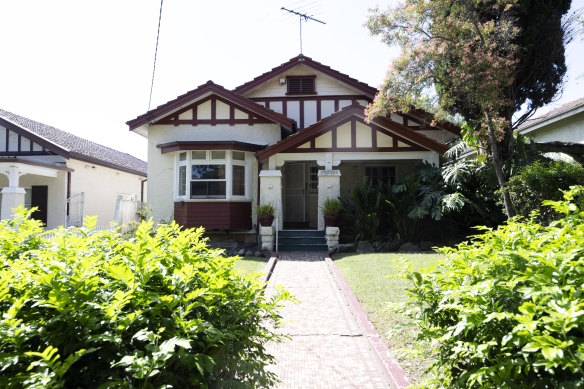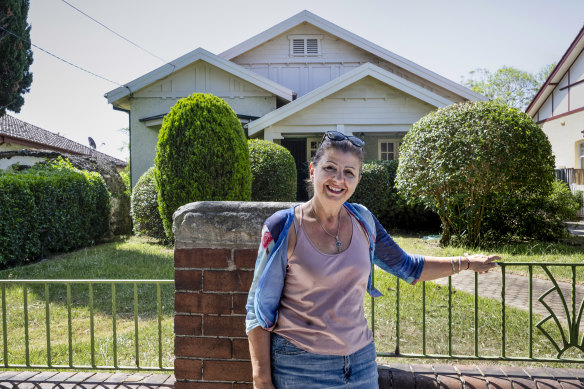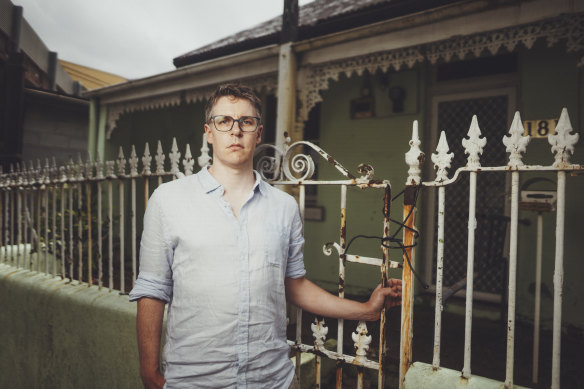This was published 1 year ago
‘Easy target’: How heritage became a lightning rod in Sydney’s housing debate
So-called NIMBYs and YIMBYs are going into battle for Sydney’s future. At issue is whether heritage protection saves much-loved suburbs or locks young people out of them.

Three Californian bungalows and a church in MacArthur Parade up for heritage listing.Credit: Janie Barrett
The Inner West Council’s final meeting for 2023 was a long one. They all are, these days. On a hot night in early December, 22 members of the public addressed councillors before the meeting even began in earnest.
Six of them (all men) spoke to one item on the agenda: a proposal to put four adjacent Californian bungalows in Dulwich Hill on the local heritage register. A group of nearby neighbours had fought for heritage protection for the homes, and a church two doors down, since 2016.
In years past, this motion might have passed quickly and unanimously, without controversy. But heritage has become a lightning rod in the battle over housing policy and affordability. So-called NIMBYs and YIMBYs are at loggerheads about whether the heritage system protects much-loved suburbs from overdevelopment, or needlessly locks young people out of areas they’d like to live in.

The heritage listing of four Californian bungalows in Dulwich Hill became a lightning rod for YIMBY activists in the inner west.Credit: Janie Barrett
The debate will only intensify with the state government’s new transit-oriented development program, which will rezone land around railway stations for greater housing density – including heritage conservation areas (HCAs). There are hundreds of these zones around Sydney, where development is severely restricted.
At the December 5 meeting, Inner West Council staff revealed that 43 per cent of the municipality is under some form of heritage protection, including all of Haberfield and much of Balmain.
Early next year, the council will consider a proposal to create nine new HCAs, extend three existing ones and make minor reductions to three others. The new zones, mostly south of Parramatta Road in Marrickville and Dulwich Hill, would capture about 1200 properties, or 2.3 per cent of the LGA – increasing the portion of the inner west under heritage protection to 45 per cent.
That alarms housing density advocates such as Sydney YIMBY co-founder Justin Simon. “If 45 per cent of the inner west is heritage significant, then it’s clear the criteria are too broad,” he says.
Heritage or housing?
All three levels of government in Australia can designate heritage items. When it comes to the impact of heritage on housing, however, we are mainly talking about the purview of councils.
While all councils list individual heritage houses, broader heritage conservation areas are highly concentrated in the inner west, north and east. The City of Sydney has 75 HCAs, and Ku-ring-gai Council 52, while Fairfield, Liverpool and Blacktown in western Sydney have none.
These provisions do not prohibit all development, but make it much more difficult (and costly). “It varies immensely,” says James Lesh, a historian, heritage specialist and author of Values in Cities: Urban Heritage in Twentieth-Century Australia.
“In general, what’s required would be the retention of the facade and perhaps the front one or two rooms. It shouldn’t prevent the modernisation of a home, or potentially, depending on where it is, some form of subdivision.” Demolition is out of the question.
Lesh supports allowing more subdivision of heritage properties, particularly large blocks in less dense areas. But he says there is little to no evidence that heritage is a barrier to housing supply.
“Heritage is an easy target for a range of broader issues that are going on related to housing and affordability and access,” he says. “Our heritage areas are actually the densest neighbourhoods in our cities. We have heaps of people living in those areas. It’s those heritage protections that are making those suburbs so liveable, and the places where both the YIMBYs and the NIMBYs really want to live.”
The four Dulwich Hill bungalows each sit on blocks of more than 1000 square metres; enough to accommodate dozens of apartments under the government’s planned changes to low- and medium-density zoning. In that context, YIMBY activists argue it’s an exemplar of how communities and councillors must choose between more heritage and more housing.
But heritage proponents don’t see it that way. “We really have an opportunity in this area to have our cake and eat it,” Marrickville resident, architect and former councillor Peter Olive told the December 5 council meeting, citing the adaptive reuse of buildings such as Marrickville Library.

Faye Papadakis outside her Dulwich Hill home. The council voted to place the house on the local heritage register.Credit: Janie Barrett
Mark Skelsey, who lives metres from the bungalows and led the campaign for their protection, said infill development at the rear of the four blocks would still be possible despite the heritage listing. “Let’s stop the anti-heritage mania,” he said.
The property owners themselves had mixed feelings. Faye Papadakis, 63, bought her home in 1991 and lives there with two of her adult sons, one of whom moved back in after his housemates could no longer afford Sydney rent.
“I’m sort of torn,” she says. “These are very large properties. A lot of the back parts are just grass, and unused. I love my home, but I’ve got mixed views because we’ve got such a shocking housing crisis. I just feel like land is very special and precious in Sydney, and we’re not utilising it.”
‘Untenable proposition’
Justin Simon, the Sydney YIMBY founder, had two unpleasant experiences as a tenant in heritage properties that proved difficult to fix when things went wrong. “They might be nice on the outside,” he says, but try living in them.
The 37-year-old, who lives in the inner west, believes heritage is a direct barrier to more affordable housing, especially as it becomes more pervasive in the popular, expensive parts of Sydney where people want to live. “It’s not the only constraint, but it is a key constraint, and it really hasn’t been talked about, despite how widespread it is,” he says.
Simon thinks there should be a limit of 5-10 per cent on how much of a local government area can be placed under such restrictions.

Sydney YIMBY co-founder Justin Simon outside a house in Glebe that is part of a heritage conservation zone.Credit: Dion Georgopoulos
“It’s an untenable proposition to say 50 per cent of our neighbourhoods are not going to change,” he says. “Eventually, some of this stuff is going to have to be torn down to create more housing, so we want to be more considered in how we apply heritage listings.”
It seems unlikely that the state government, desperate as it is for more homes, would tear down heritage-listed parts of Balmain – despite it being within 1200 metres of the planned Bays West Metro station. Yet both the government and YIMBY types are keen to encourage adaptive reuse, where heritage properties can be built upon and renewed.
Supporting documents for the government’s transit-oriented development program clearly state that communities in heritage areas should be prepared for “significant change”. Premier Chris Minns, asked about the looming clash, said while heritage orders weren’t being discarded, they were too often used as “a way of preventing development and saying ‘no’ without being upfront about it”.
He singled out Sydney’s inner west as an example. “It’s virtually impossible for young people to move into that community,” Minns told ABC radio. “They want to live there, it’s close to the CBD, you can cycle, you can walk. We’re building a $26 billion Metro public transport solution for that community, and there needs to be more density.”
‘Last line of defence’
During a debate on a heritage listing earlier this year, Woollahra councillor Luise Elsing explicitly stated that heritage protection was “our last line of defence” against overdevelopment. Statements like it fuel the perception that heritage is being misused to prevent development some don’t like, or density some don’t want.
Simon says that for some, the entire point of heritage is “to freeze their areas in time and lock out new residents who may compete for parking or who may also use those public goods that they seek to monopolise”.
He wins some agreement there from Lesh, the heritage expert. But Lesh says it applies to NIMBYs and YIMBYs alike: both misuse, or weaponise, heritage to suit their agendas.
“The idea that we want everything to stay the same is contrary to heritage,” he says. “The heritage of our cities is about constant change, constant development and constant densification as well.”
Inner West Council ultimately voted 12-3 to heritage-list the four Dulwich Hill bungalows. Three Labor councillors – mayor Darcy Byrne, deputy mayor Chloe Smith and former Balmain Labor candidate Philippa Scott – dissented to oppose the listing, revealing it is an issue that splits the Labor Party.
Byrne says of his decision: “It was clear to me that creating a new heritage conservation zone there was not unanimously supported, it was contentious and there were numerous property owners who didn’t want an additional heritage control on their property and didn’t feel as though they had been part of the initial decision.”
It was also a litmus test for the bigger debate to come about nine new heritage conservation areas that have been recommended by consultant GML Heritage. Byrne hasn’t decided how he will vote, but he says they should be decided on a case-by-case basis, rather than rubber-stamped.
“Given such large swaths of the inner west already are covered by heritage conservation zones, I think we’ve got to be careful and thoughtful about why and where we would expand them further,” he says. “Because we’re the oldest suburbs in Sydney, there are a lot of places that have enormous heritage value and, generally, they are already protected.”
Byrne has been a councillor for 15 years and witnessed first-hand the rapid change in discourse about housing and heritage, prompted by the sheer scale of the affordability crisis.
“You’ve got a whole generation of younger people in Sydney who see no hope of homeownership in the communities that they want to live in,” he says. “I’m not surprised that both sides of the debate have their base in the inner west of Sydney. We are a very political community.”
Start the day with a summary of the day’s most important and interesting stories, analysis and insights. Sign up for our Morning Edition newsletter.